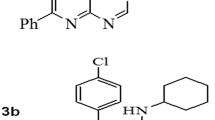Abstract
The present study deals with the kinetics and thermodynamics of the uptake of75Se-labeled SeO 2−3 from incubation media to lymphocytes cultivated from eight normal individuals (14–55 years of age, two females).
The uptake of SeO 2−3 was evaluated on the assumption of pseudo-first-order kinetics with regard to a reacting cellular receptor pool. On the basis of the experimental observations, it was assumed that the suggested pool of receptor molecules-symbolically represented by “£H4”—reacts with SeO 2−3 in the hypothetical reaction:
The mean value of the change in standard free energy at 25°C was calculated to be ΔG o=−141.6±1.3 kJ/mol, while the corresponding mean value of the free energy of activation at 25°C was calculated to be ΔG 2+=−7.8±0.9 kJ/mol for the forward reaction.
The calculated values of the corresponding individual changes in the respective standard enthalpies and entropies were mutually interdependent for all eight donors. ΔH o=−152+315ΔS o(kJ/mol) corresponding to the common value ΔG o≅−152 kJ/mol at 315°K. These mutual interdependencies are possibly the effect of variable conformational states (e.g., the macromolecular compactness) of the cellular receptor pools. This suggestion may furthermore be supported by the correlation traced between ΔH o vs the biological age in years of the donors: △H °≃76.7−1.0 (age)kJ/mol (r = −0.92)
The calculated values of activation enthalpy ΔH 2+ kJ/mol and activation entropy ΔS 2+ (kJ/mol K) also mutually correlated linearly (r=0.998); the regression line was: △H 2+ = −8.9 + 305△S2+ (kJ/mol) corresponding to the common value △H 2+ △ −8.9 (kJ/mol) at 305°K
Similarly the activation enthalpy ΔH 2+ vs the biological age in years correlated linearly: ΔH 2+=67.4−0.73(age) (kJ/mol) (r=−0.76)
The range of ΔH 2+ studied was from 13.8 to 53.9 kJ/mol with a linearly corresponding range in ΔS 2+ from 73 to 205 J/mol K.
The thermodynamic data reveal the selenite uptake during the hypothetical standard reaction to be exergonic and endothermic. Critical pH dependencies of the selenite uptake were explained.
Similar content being viewed by others
References
K. Schwarz and C. M. Foltz,J. Am. Chem. Soc. 79, 3292 (1957).
L. Flohé, W. A. Günzler, and H. H. Schock,FEBS Lett.,32, 132 (1973).
J. T. Rostuck, W. C. Hoekstra, A. L. Pope, H. E. Ganther, A. Swanson, and D. Hareman,Fed. Proc. 31, 691 (1972).
H. E. Ganther, inSelenium, (R. A. Zingaro and W. C. Cooper, eds., Van Nostrand-Reinhold, Princeton, New Jersey, 1974, pp. 546–614.
J. T. Rostruck, A. L. Pope, H. E. Ganther, A. B. Swanson, D. G. Hafeman, and W. G. Hoekstra,Science 179, 588 (1973).
D. E. Metzler,Biochemistry. The chemical reactions of living cells, Academic Press, New York, 1977, p. 536.
I. M. Aria and W. B. Jacoby, eds.,Glutathione, Metabolism and Function, Raven Press, New York, 1976, p. 117.
H. Tanaka and T. C. Stadtman,J. Biol. Chem. 254, 447 (1979).
R. A. Zingaro, J. E. Price, and C. R. Benedict,J. Carbohyd. Nucleosides Nucleotides 4(5), 271 (1977).
E. P. Painter,Chem. Rev. 28, 179 (1941).
M. Sandholm and P. Sipponen,Arch. Biochem. Biophys. 155, 120 (1973).
A. Böyum,Scand. J. Clin. Lab. Invest. 21, Suppl. 97, 77 (1968).
K. Diem and C. Lentner, eds.,Documenta Geigy, Scientific Tables, Basel, Switzerland, 1975.
H. Netter, “Membranpotentiale, Donnan, Gleichgewichte und active Transport,” inBiochemisches Taschenbunch, Vol. II, H. M. Rauen, ed., Springer Verlag, Berlin, 1964, p. 192.
G. E. Jensen, G. G. Nielsen, and J. Clausen,J. Neurol. Sci. 48, 61 (1980).
E. A. Dawes,Quantitative Problems in Biochemistry, Longman, London, 1980, p. 71.
E. A. Stearn,Adv. Enzymol. 9, 25 (1949).
Author information
Authors and Affiliations
Rights and permissions
About this article
Cite this article
Clausen, J., Tranum, J. Kinetics of selenite uptake by mononuclear cells from peripheral human blood. Biol Trace Elem Res 4, 245–258 (1982). https://doi.org/10.1007/BF02786539
Received:
Accepted:
Issue Date:
DOI: https://doi.org/10.1007/BF02786539




